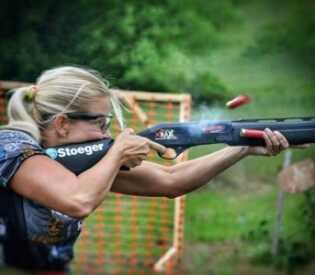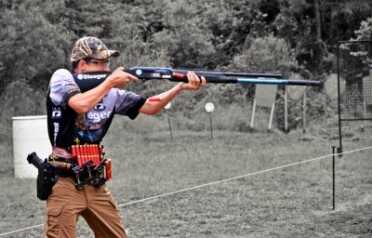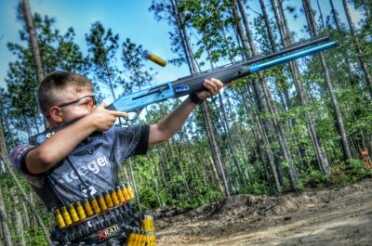
Author Becky Yackley during 2016 3 gun Pro Am, focused on aggressively engaging a series of knock-down targets.
Introduction:
Last time we talked shotguns we looked at the basics involving stance, proper fit, safe handling, and loading.
We suggested that you use dummy rounds and dry fire to familiarize yourself with the processes unique to your gun.
We talked about developing an eye for lead and the need to “be one” with your firearm, meaning that you have to put your gun through its paces so that shooting it and hitting targets becomes instinctive.
Now we’re going to dive a little deeper, specifically as it relates to mounting a shotgun, transitioning or swinging a shotgun and shooting on the move. And these are skills you will need if you plan to start shooting practical shotgun matches or 3 gun.
The Series:
- Ep. 1 Getting Started
- Ep. 2 Steel Challenge
- Ep. 3 USPSA Pistol
- Ep. 4 Shotgun
- Ep. 5 3 Gun
- Ep. 6 High Power Rifle
- Ep. 7 Cowboy Action
- Ep. 8 Shotgun II
- Ep. 9 IDPA
- Ep. 10 Bulls Eye Pistol
- Ep. 11 Smallbore Rifle
Mounting the Gun
This is a very beneficial place for a new shooter to spend time with their shotgun. Mounting a gun in practical shooting is usually done with one of two main methods: 1. Port Arms, or 2. Low Ready. There are others, such as table starts and IPSC-style “receiver parallel to ground” starts, but they are not as common.
For low ready, you start by shouldering the gun to take a sight picture and then you drop the muzzle to a low ready position. For port arms, you drop the buttstock and lift the port high enough so that the buttstock is at your belt and the muzzle is generally above your shoulder. The key to both of these starts is not lowering the gun more than is necessary, and practicing until the movements are clean and smooth.
Mounting the gun is important to practice because a poor mount will set you up for failure. If you don’t get the gun high enough into your shoulder, your eye may not come to the same place as you normally shoot and this will affect not only your sight picture but your ability to manage recoil may be impacted and your entire string of fire will fall short of your goal.
While it seems rather obvious and simple, mounting the gun properly is a big deal whether you’re shooting only one target or shooting a string of fire that might have 12 targets. Of course, the longer the string of fire the more a poor mount can mar your performance. Get comfortable mounting your scatter gun!
Swinging a Shotgun
Shotguns are sometimes on the heavy side in practical shooting because of how many rounds we load (9 to 20 +, depending on your division). They have very long tubes, and we’re holding them out in front of our bodies for prolonged periods of time. Nothing about that makes it convenient to haul ass with them, and whether it’s in a straight line or side-to-side, they’re cumbersome. So we have to think back to that position we talked about with sporting clays and skeet and being able to uncoil and move.
What we want to strive for is a fluid movement, without fighting our momentum and our own body, and without any up and down. When I teach skiers how to turn, I look at their bodies, do they pop up mid-way through or at the end of the turn? That tells me something about how they set up for the turn. The same thing goes for swinging a shotgun; you have to set up.
Try this: stand up really straight and tall, like a soldier in formation. Now hold your arms like you have a shotgun in them. While maintaining that upright, straight-back position, try to swing 180 degrees from side to side. Not so graceful is it?!
Now, take an aggressive stance: feet separated and weight forward like you’re ready to counter someone who wants to push you backward, then swing. See the difference?
Pistol shooters are taught to transition from target to target similarly with the power coming from the knees and body moving like a tank turret. You don’t want to swing your gun and upper body while your lower body is playing catch up. You want to swing or transition as a unit.
Swinging a shotgun is very similar to transitioning with a pistol, except you have a much bigger gun and much more weight. Your foot placement becomes critical, and you have a lot of room to make your stance your own and see what works for you, while maintaining the principles of good stance: bend in your knees, weight over the balls of your feet, hips slightly forward, shoulders rounded, and a functional tension in your core to counteract and absorb the recoil of the gun. Some people will play with a narrower stance, toes pointed slightly outward, others find one foot forward helpful.
Again, it’s going to take some practice before you master swinging your shotgun. Set up your phone or a camera, watch how you move and see what changes when you change your position. Does your gun stay level, are you off balance? Can you transition without needing to pivot your feet?
Shooting on the Move
The biggest thing to be aware of in shooting a shotgun on the move is the amount of active muscular tension that needs to be held in your core. Folks often call this an aggressive stance or posture. But there’s more to it than standing with your body weight over the balls of your feet. You hold this position as you move and your muscles have what is called “functional tension.”
The best description I’ve heard of functional tension is to imagine you’re holding a weight to do a bicep curl and then you make that motion. You can either make the motion as if you’re holding a weightless weight, or pretend you have an actual 15-pound weight in hand. That tension you hold when pretending to do it with the weight is something like what you should feel when you are maintaining functional tension in any other part of your body.

Knowing when to shoot while moving, 7 when to post up to get your hits are both skills learned through experience.
When you shoot a shotgun, your core should feel like you’re ready to counter someone pushing you backward. And that might be the best experiential way to teach what you need to feel. Hold your empty shotgun out like you’re shooting, and have someone push back on it by giving a push to the fore-end. It doesn’t take much to put you off balance, so figure out what you need to do so you can’t be thrown off balance!
The second thing to be very aware of is that you don’t want to shoot out of sync with your footfalls. You can’t plod through the movement without seeing the sights dip considerably, strive for rolling footfalls. And as you move, keep your legs bent and hinge forward at your hips enough to keep from being thrown upright or off balance by the recoil of the gun.
Dry fire “walking” through a row of steel is a good way to practice this, then adding live fire as you go. By walking it first with your gun, and transitioning from target to target, you will be able to see what happens to your sights when you step, and learn how to walk smoothly.
Shooting while moving is something that you need to practice because it feels weird at first. And you need a good sense of balance and control in your body. You have to work at it, but you can dry fire to practice, and work on the smoothing out your movement.
Think with Your Eyes!
Just like any other part of shooting, when shooting on the move and transitioning you have a lot going on visually: what your sights tell you, what your peripheral vision tells you about your location within a stage, what your recoil tells you. Are you looking at the target and where your hits went? Are you thinking about the next target and what you visualized in your stage walk-through?

Attention to visual details is an important skill to sharped for any type of shooting.
When transitioning your shotgun from one target to another, either in a string of fire or between two targets, the goal is to swing the gun fast and get your eyes there first. You have to know what you’re looking for, and when you swing, eyes move first and gun catches up. How fluidly you do this, stop, and set up for the shot, and how long it takes will require you to practice.
Practice snapping your eyes their first, and the gun should slow down a fraction before you’re at the target so you can pull the trigger once it’s on target. Learning what you need to see with any firearm is really important. We can practice what we need to see from our gun in dry fire, and we can practice while walking a stage what we want to see to find targets. But being aware that every marksmanship principle we apply is driven by what we see and the feedback our eyes give us will help us to improve over time. So think with your eyes!
Conclusion
In the end, we can’t let our visualization drive us through our stage if we don’t know what good shooting feels like. What it feels like to properly mount the shotgun, to transition fluidly and move with it aggressively. So, yes, it takes practice!

Anyway to reduce the volume on the intro music? It is very loud often followed by low volume audio from the host/presenter.
It’s annoying to lower have to lower the volume during the intro and crank it back up to be able to,hear the speaker.
Thanks Patrick…yes, we’ll get on that:-)